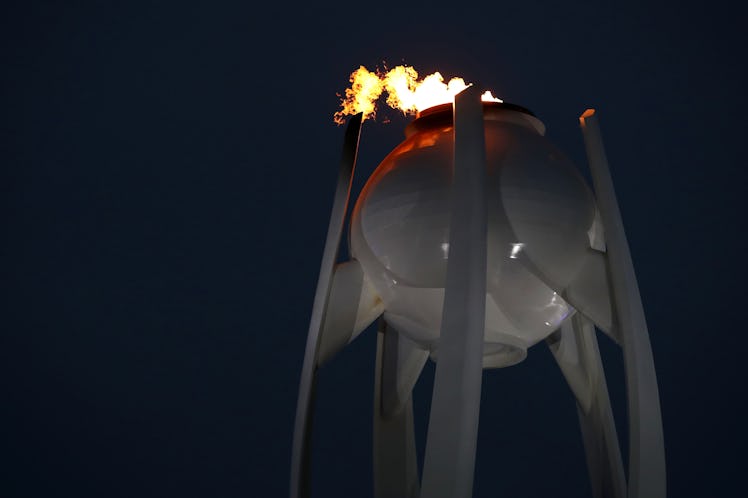
Here's What Happens To The Olympic Flame After The Winter Games
If watch you've watched both the opening and closing ceremonies of any Olympics in the past, you know the routine. At the opening ceremony, the Olympic flame is lit in a cauldron, burning for the duration of the games, before being extinguished during the closing ceremony. But you might not know what happens to the Olympic torch after the Winter Games end.
That's because the flame is not needed in the period between each version of the Olympic Games. An Olympic flame is only created for one Olympiad, and it all starts months before the sporting event is held.
Take the 2018 Winter Olympics in PyeongChang, for example. The Olympic game for these Winter Games was lit last October, during a ceremony in Greece, the birthplace of the Olympics. Traditionally, the flame is created during the ceremony by using a mirror to focus the sun's rays on an Olympic torch, according to NBC. From that point on, the same flame is kept until the end of the Olympic Games for which it was created. In addition, per NBC, a backup flame is created to ensure that, in the event the flame is extinguished by mistake, it can be re-lit using the same ember created at the lighting ceremony in Greece.
For the PyeongChang Olympics, there was just one wrinkle to the tradition. It just so happened to be a cloudy day on Tuesday, Oct. 24, the day the Olympic flame for the 2018 Winter Games was lit. Because of the weather, the flame couldn't be created with the help of the sun, according to CBC, so a backup flame that was created days earlier during a rehearsal was used to light an Olympic torch instead.
Besides that little modification, the ceremony went on as expected with the usual amount of pageantry that the International Olympic Committee (IOC) is known for — which, for the lighting ceremony, included actresses playing the role of priestesses and the president of the IOC providing the usual pep rally-type speech.
"Now it will be up to PyeongChang to keep the dynamism for the last three months of preparations," International Olympic Committee president Thomas Bach said at the ceremony, per CBC. "They are very well under way, the stage is set for the winter athletes of the world and we are looking forward to a successful and great Olympic Games in PyeongChang."
After the flame is lit, it embarks on a journey that is months long and covers a distance of thousands of miles. That journey is known as the Olympic torch relay, which sees different torch bearers pass on the flame to others at different stops around the world.
Though the Olympics and the torch relays are marketed as events that are all about enjoyment and openness to the world, some of the relay stops can become disruptive, as they have been known to draw protests in the past. In 2008, before the Summer Olympics in Beijing, multiple stops on the torch relay's tour drew demonstrations, including one in San Francisco.
On that occasion, protesters gathered to demonstrate against China's human rights record. China, of course, didn't take too kindly to the protests.
"We express our strong condemnation to the deliberate disruption of the Olympic torch relay by Tibetan separatist forces regardless of the Olympic spirit and the law of Britain and France," a spokeswoman for the Chinese Foreign Ministry said at the time, per CNN. "Their despicable activities tarnish the lofty Olympic spirit and challenge all the people loving the Olympic Games around the world."
The next torch relay on deck? A tour that will see the Olympic flame travel to Tokyo, where the 2020 Summer Olympic Games will be held. That is, after the flame is lit months prior in Greece, again.